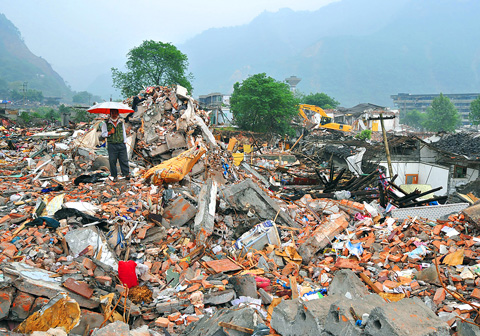A big aftershock rattled southwest China yesterday, killing at least one person and injuring 400, state media reported, nearly a fortnight after a big quake killed tens of thousands in the same area.
More than 70,000 houses were toppled during yesterday’s tremor in Sichuan Province, state TV reported. The 5.8 magnitude aftershock was epicentered 40km west-northwest of Guangyuan, the US Geological Survey said.
At the same time hundreds of troops carrying explosives were trekking through the area, attempting to reach a “quake lake” that threatened a secondary disaster.

PHOTO: AFP
Concerned by a rise in the water level of a giant lake at Tangjiashan, authorities have been seeking to blast a hole in the barrier before it bursts and causes a flashflood. Thousands have been evacuated below the lake as a precaution.
Chinese Premier Wen Jiabao (溫家寶), who believes the overall death toll from the main quake could exceed 80,000, has said the main concerns are now secondary disasters like flooding and landslides, epidemics and providing shelter for the millions of displaced.
State TV earlier reported that an 80-year-old partially paralyzed man was the longest known survivor to date. He was pulled alive from the rubble on Friday, 266 hours after the 7.9 magnitude quake hit.
The man was rescued in Mianzhu City, where he had been trapped under a collapsed pillar of his house. He had survived after being fed by his wife, the TV report said.
The biggest concern among the dozens of quake lakes is the one at Tangjiashan, which rose 1.93m yesterday to 723m, Xinhua said.
“The relief work for Tangjiashan quake lake is now at critical stage,” Vice Minister of Water Resource E Jingping (鄂竟平) told a news conference in Beijing.
“The daunting difficulty in treating a quake lake is its unpredictability — its formation and when it could burst,” he said.
But a military expert near the wrecked town of Beichuan said the lake did not pose an immediate threat.
“This is a precautionary step in case there is rain over the coming days. The dam is far from overflowing yet, but we need to release water in case the predicted rains come,” said the People’s Liberation Army officer, surnamed Liu.
Forecasts of rain added to worries yesterday about relief efforts to house the millions of people left homeless by the earthquake.
The government warned that heavy rain was on the way, possibly hampering work to get temporary shelters up to house the estimated 5 million who lost their homes in Sichuan Province.
The State Meteorological Bureau said yesterday that parts of Sichuan would suffer “heavy and even in some areas torrential rains” later yesterday and today.
The bureau warned of “possible mudslides” caused by the heavy rain.
Rescuers were also trying to reach 24 coal miners who officials said were trapped in three mines by the disaster, though they didn’t know if the miners were alive.
Xinhua news agency said that China’s customs office had streamlined entry procedures for relief materials and rescue personnel. It said that on Saturday 47 batches of overseas relief materials, including tents and medicine had arrived in quake-hit areas. Aid is being sent by large and small countries.
Also See: Games organizers shorten torch’s trip through Tibet

SECURITY: As China is ‘reshaping’ Hong Kong’s population, Taiwan must raise the eligibility threshold for applications from Hong Kongers, Chiu Chui-cheng said When Hong Kong and Macau citizens apply for residency in Taiwan, it would be under a new category that includes a “national security observation period,” Mainland Affairs Council (MAC) Minister Chiu Chui-cheng (邱垂正) said yesterday. President William Lai (賴清德) on March 13 announced 17 strategies to counter China’s aggression toward Taiwan, including incorporating national security considerations into the review process for residency applications from Hong Kong and Macau citizens. The situation in Hong Kong is constantly changing, Chiu said to media yesterday on the sidelines of the Taipei Technology Run hosted by the Taipei Neihu Technology Park Development Association. With

CARROT AND STICK: While unrelenting in its military threats, China attracted nearly 40,000 Taiwanese to over 400 business events last year Nearly 40,000 Taiwanese last year joined industry events in China, such as conferences and trade fairs, supported by the Chinese government, a study showed yesterday, as Beijing ramps up a charm offensive toward Taipei alongside military pressure. China has long taken a carrot-and-stick approach to Taiwan, threatening it with the prospect of military action while reaching out to those it believes are amenable to Beijing’s point of view. Taiwanese security officials are wary of what they see as Beijing’s influence campaigns to sway public opinion after Taipei and Beijing gradually resumed travel links halted by the COVID-19 pandemic, but the scale of

A US Marine Corps regiment equipped with Naval Strike Missiles (NSM) is set to participate in the upcoming Balikatan 25 exercise in the Luzon Strait, marking the system’s first-ever deployment in the Philippines. US and Philippine officials have separately confirmed that the Navy Marine Expeditionary Ship Interdiction System (NMESIS) — the mobile launch platform for the Naval Strike Missile — would take part in the joint exercise. The missiles are being deployed to “a strategic first island chain chokepoint” in the waters between Taiwan proper and the Philippines, US-based Naval News reported. “The Luzon Strait and Bashi Channel represent a critical access

Pope Francis is be laid to rest on Saturday after lying in state for three days in St Peter’s Basilica, where the faithful are expected to flock to pay their respects to history’s first Latin American pontiff. The cardinals met yesterday in the Vatican’s synod hall to chart the next steps before a conclave begins to choose Francis’ successor, as condolences poured in from around the world. According to current norms, the conclave must begin between May 5 and 10. The cardinals set the funeral for Saturday at 10am in St Peter’s Square, to be celebrated by the dean of the College